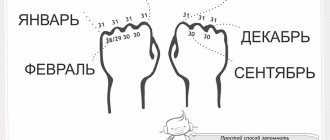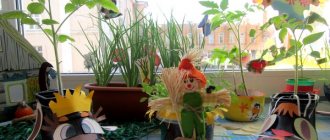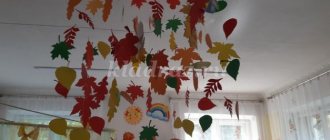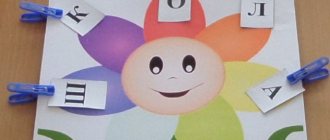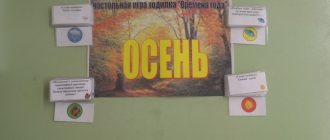Didactic manual “Miracle Tree” for kindergarten
Didactic manual “Miracle Tree” for preschool children
Didactic manual “Miracle Tree”
Description. I bring to your attention the teaching aid “The Miracle Tree”. The material is intended for kindergarten teachers. The manual can be used on lexical topics “Birds”, “Fruits”. And also for automation and differentiation of sounds. Multifunctionality lies in the use of different pictures. The manual is designed for individual and subgroup work with preschool children. Method of making the manual. Take a sheet of A4 paper, draw a picture of a tree on it or use a ready-made image. Laminate it with film for pasting textbooks.
Cut nest-pockets from transparent film and attach to tree branches using double-sided tape.
Select pictures of birds and cover them with tape.
Didactic game “Birds in nests”
Purpose: To consolidate children’s knowledge and ideas about migratory and wintering birds. Clarify the name of the birds, practice recognizing birds by their description. Learn to coordinate nouns with numerals. Develop phonemic awareness, determine the presence of sound in a word. Automate the sounds L, R, Rub, S. Game options.
1 task “Say it in one word”
Pictures of birds are laid out in front of the child. The teacher asks the child to name who is shown in the pictures. Then he suggests choosing a generalizing word.
Task 2 “Wintering birds”
The teacher invites the child to select and place only wintering birds in the nests. The child resettles the birds by pronouncing their names.
Task 3 “Count and name”
The teacher places the birds on the tree and asks the child: “How many birds have arrived?” The child counts the birds and sums them up at the end of the count. For example, one rook, two rooks...five rooks. Five rooks flew in.
Task 4 “Where is the bird sitting?”
The teacher invites the child to place the birds on a tree branch, above a tree, under a tree, on a branch. The child seats the birds, pronouncing their location.
— A crow over a tree. - Magpie on a tree. - Rook under the tree. — The sparrow is to the right of the tree. — The rook is to the left of the tree. The teacher monitors the correct use of prepositional-case constructions.
Task 5 “Find out by description”
The teacher asks the child to guess riddles about birds. Nimble, fast, dexterous, pugnacious, brave, fighting ... (sparrow) Red-headed, large, smart, wintering ... (woodpecker) Nimble, cheerful, long-tailed, migratory ... (swallow) Big-eyed, sleepy, nocturnal, sedentary, wintering ... (owl) The child guesses the bird, names it and places it in the nest.
Task 6 “Birds in nests”
The teacher asks the child to place in the nests only those birds whose names contain the sounds S, S'. Similarly with the sounds R, Rb, L.
Task 7 “Who flew away?”
The teacher places birds on the tree whose names contain the sound S. Invites the child to look carefully and remember the birds. Then the child closes his eyes, and the teacher removes one bird. Who flew away?
Task 8 “Who’s the odd one out”
The teacher places birds in nests: jackdaw, swallow, dove, oriole, woodpecker, falcon and crow. Invites the child to look carefully and find the extra bird whose name does not have the sound L.
We recommend watching:
Do-it-yourself multifunctional game aid for preschoolers Do-it-yourself didactic aid for younger preschoolers Do-it-yourself didactic aid for kindergarten Do-it-yourself didactic aid “Paired Pictures” for kindergarten
Similar articles:
Game layout for children 4-7 years old “My City”
Multifunctional teaching aid for children 5-6-7 years old
Do-it-yourself manual for developing fine motor skills
MAGAZINE Preschooler.RF
Multifunctional manual “Miracle Tree”.The manual is used in many areas of educational activity of children 2-3 years old and helps to achieve many goals and solve educational problems:
- Socialization.
Development of gaming activities: to develop the ability to show interest in the gaming activities of peers. Help them play nearby without interfering with each other. Develop the ability to play with peers. Develop the ability to perform several actions with one object and transfer familiar actions from one object to another. Enrich children's sensory experience, compare, correlate, group, establish the identity and difference of homogeneous objects according to one of the sensory attributes (color, shape, size). Conduct didactic games to develop attention and memory ( “What’s missing?” , “What’s extra?”, etc.), to develop hand motor skills (attaching objects to a tree or a garden bed using Velcro). Introduction to basic generally accepted norms and rules of relationships with peers and adults: develop the ability to play without quarreling, help each other and enjoy success together.
- Cognition. Sensory development: continue to work to enrich children's direct sensory experiences. Help examine objects, highlighting color, size, shape. Exercise in establishing the similarities and differences between objects that have the same name (for example: a red leaf, a green leaf, a yellow leaf). To develop the ability to name the properties of objects (an apple is green, sweet, etc.).
Formation of elementary mathematical concepts: involve children in the formation of groups of homogeneous objects. To develop the ability to distinguish the number of objects: many - one (one - many).
Formation of a holistic picture of the world, expansion of horizons: teach children to name colors, compare objects (red apple, green apple, yellow apple), select objects by identity (find the same piece of paper). Teach children to distinguish fruits (apple, pear) by appearance. To form elementary ideas about seasonal changes in nature: in autumn the leaves turn yellow and red, vegetables and fruits ripen. In winter, there are no leaves on the trees, snow falls, you can sculpt snowmen and look at snowflakes. In spring, the first leaves and flowers appear on the trees. In summer there are green leaves on the trees and flowers bloom on the grass.
- Communication. Offer individual objects (leaves, snowflakes, etc.) for independent examination as visual material. Tell children about them, encourage children to communicate with each other. Activate children's vocabulary. To develop children’s ability, following the teacher’s verbal instructions, to find objects by name, color (take an apple, attach a snowflake to a tree, remove red leaves from a tree, etc.), and name their location (pear high, leaves low). Enrich children's vocabulary with nouns denoting the names of fruits; verbs denoting actions (find, attach, remove); adjectives denoting color, size, taste, temperature (cold snowflake)
- Artistic creativity. Develop aesthetic perception. Look at the pictured tree with the children, draw their attention to how beautiful, bright, neatly made and drawn it is.
“Miracle Tree” is made of plywood and coated with Senezh . Small items are attached to the tree using Velcro.
Examples
didactic games, tasks using the “Miracle Tree”
- Name each item.
- Name the objects in one word (fruits or vegetables)
- Where do fruits grow? (on the tree)
- Name the green fruits
- Find yellow fruits
- Find green apples (etc.)
- What's extra? (there are no snowflakes in summer, etc.)
- Help the bunny cook compote
- Attach green leaves to the tree
- Pick yellow apples from the tree
- Pick 2 apples from the tree
- Attach a leaf above the apple
- Attach the pear under the leaf
- Tell me where the pear grows? (high), where is the leaf? (low)
- Which snowflake is warm or cold?
- Name the color
- What's missing?
- Find where the apple fell from the tree (into the garden bed)
- Show me the tree trunk
- Show tree branches
- Determine with your eyes closed what kind of object it is (snowflake, pear)
And also many other tasks - it all depends on the teacher’s imagination. And this is only for children of the younger group.
In middle and older groups, you can also successfully use this manual by solving other problems appropriate to the age of the children.
As the seasons change, the appearance of the tree also changes. In winter it is white, without foliage, decorated with snowflakes.
In the future you can supplement it with bullfinches and sparrows. In spring (when fruit trees begin to bloom), the tree turns over to its green side and is decorated with pink and white flowers and green leaves. In summer, the flowers move to the garden bed. And in the fall, the vegetable garden ripens, and yellow and red leaves and fruits appear on the tree - either apples or pears. In the future it will also be possible to add mushrooms.
| Next > |
"Miracle - Tree."
"Miracle - Tree."
Lesson on the formation of behavioral and socio-moral qualities in children of senior preschool age.
Target
: Formation of social and moral qualities in students.
Tasks
Educational
:
- cultivate a sense of goodwill, empathy, responsiveness, the need for friendly relationships;
- cultivate the desire to do good deeds.
Educational:
— to form the idea that kindness is a manifestation of the soul.
— improve dialogic and monologue forms of speech;
— improve cognitive activity;
Educational:
- stimulate the development of children’s thinking abilities;
- develop the ability to observe, highlight, compare, analyze;
— develop fine motor skills, motor activity, coordination of movements;
Equipment and attributes:
puzzles with the image of Leopold the cat; magic basket; bag; a series of pictures of a bad and a good deed; blue fabric; record player; musical accompaniment; preparations of hearts, suns; planks for the bridge; eraser, pencil, slippers (for children), scissors, watering can, book;
A series of pictures with fairy-tale characters, good and evil; glue; envelopes 4 pieces.
Preliminary conversation:
conversations on the topic of what is good and evil, bad and good deeds; looking at a series of pictures about actions, reading works of art; losing games.
Progress of the lesson.
Psychologist
: Hello guys! I'm very glad to see you all. Today is such a good day. Let's give each other smiles so that our souls will be joyful and calm. Let's hold hands and look into each other's eyes. Guys, I really love giving gifts and I have prepared a surprise for you - this is an unusual, special gift called a miracle - a tree. And his secret is that when people look at him, their hearts are filled with kindness and love, and a smile appears on their face.
(recording of thunder sounds).
The children hide with the psychologist, and when they return to the tree, they see that all the flowers and leaves on the tree have disappeared, the children do not understand what happened.
Psychologist:
- Guys, look what happened to our tree, it withered, all the flowers and leaves fell off. Why do you think this happened (children's answers)
-maybe he was bewitched, but who could do it? (audio recording)
Laughter of the evil sorceress
(children's answers.)
Psychologist
:
-Let me help you with your guesses and (tells)
-Most of the people who surround us are kind, loving people. But, despite this, there is evil in our world, the mistress of which is the sorceress Zlyuka. She doesn’t like cheerful, kind, good people and she tries to quarrel with them, make them evil, scary, disgusting, sowing seeds of fear, evil, indifference, from which trees of hatred, malice will grow, turn into dense forests and forever remain in our world, making people evil and scary. And now, in order to harm us, she bewitched our miracle tree.
Goal: formation of perception of color, shape, size of objects. Objectives: Educational: Teach children to group objects according to one of the characteristics: shape, color, size; Acquaintance with the surrounding world, with natural phenomena; Fix the names of wild and domestic animals; Exercise children in identifying and naming colors, sizes, shapes, geometric shapes, through visual and tactile examination and comparison. Developmental: Develop fine and gross motor skills, coordination of movements; Develop tactile sensations, visual and auditory perception; To develop the ability to correlate forms with real objects; Enrich children's vocabulary, the ability to use speech as a means of communication; Develop attention, memory, thought processes. Educational: Cultivate curiosity, expand the experience of orientation in the environment, enriching children with a variety of sensory impressions; Foster mutual understanding, friendliness, and respect for each other.Progress of the game
I. _ SENSOR MAT. This is such a wonderful clearing - Come on, play with us. To become smart, we need to touch everything.
We examine the object - We highlight the shape, color. Think Vova, Sasha, Dasha. Help with our fingers. One, two, three, four, five Let's count fingers Strong, friendly These are so necessary.1. To keep the trailer on the road, you need to tighten the wheels. The colored trailers run, run, run, and the round wheels go on and on. The locomotive began to whistle and the carriages began to move. Chu-chu-chu, I'll rock you far.
2. We are going, going, going, to distant lands. Here are hares and bears, cheerful friends.
Game "Train" . Invite children to place a wild or domestic animal in the trailers. Goal: learn to name colors, consolidate the names of animals, develop speech.
3. It’s time for all of us to know this wonderful game. Here is a circle and a square, they all lie in a row. Come on, my dear friend, show us the circle.
Game "Form" . Find a shape similar to a square, triangle, etc. Goal: learn to name a geometric figure, the ability to relate shapes to real objects.
4. Here is a wonderful shoe, untie it, my friend. Someone is hiding inside, try and unfasten it.
Game "Slipper". Goal: to develop coordination of movements, attention.
5. What an aquarium, why is it empty? Take a big fish and put it in the aquarium.
Game "Put a fish in the aquarium." Goal: Learn to compare an object: big - small, determine quantity: one - many.
II . MIRACLE TREE. Children play these games with pleasure, and it became an idea for me to create a tree of four colors for this clearing.
Just like at our gate, a miracle tree grows. Miracle, miracle, miracle, wonderful.
Game "Decorate the tree." Invite children to decorate the tree with leaves, flowers, apples, and geometric shapes. Goal: to develop motor skills, thought processes, enrichment of sensory experience.
Game "Sunshine and Rain". Rain, rain, come and fall on our earth Let the earth drink some water And give it to the plants Rain, rain, more The grass will be thicker, Rain, rain, more heavily, You are our vegetable garden of fields. Look carefully, find the clothespin by color. Our rain, you decorate and repeat the colors.
Invite children to decorate the rain with clothespins according to color. Goal: name the color, develop motor skills.
III . MAGICAL GLASS. Well, once, well, twice, there is a lot of magic here. There is another clearing, what an interesting one.
Game "Sort clothes by color." Purpose: Getting to know children's clothing.
Game "Vegetables". Goal: to consolidate the concept of vegetables.
Game "Fruits". Goal: concept of fruit.
In more complicated versions. I suggest using this manual to familiarize yourself with the outside world and natural phenomena. For middle aged children. Like nature's calendar. Blue is winter, green is spring, red is summer, yellow is autumn. On a walk we observe, it is snowing, the wind is blowing, the sun is shining. Using nursery rhymes and poems. Spring is the color green, we will give you this advice. Everything turns green and blooms, bringing joy to everyone around. Red is the color of summer, everything around is warmed with warmth. The yellow color is autumn, look at the forest, all its leaves have dropped. Blue color - winter, snow falls on houses.
Game “Who is dressed, how in winter, spring, summer, autumn” Goal: to consolidate the concepts of clothing, shoes.
Look carefully: What should we wear in winter? In spring and summer? Fur coat, hat, boots Dress, jacket, shoes. Game “What kind of birds fly to the site” Purpose: acquaintance with wintering birds. We went for a walk. There are the pigeons, look. Sparrow, tit. What kind of bird is this?
Game "What's the weather?" Goal: to expand children’s understanding of natural phenomena.
IV . OPTION . You can also use the back side of the tree.
Game "Who lives in the forest, on a tree." Here is a tree, here is a trunk. Both branches and leaves. There is a squirrel on the tree. She lives in a hollow. And the bird is in a nest, or in a birdhouse.
V. _ MAGICAL GLASS.
Well, once, well, twice, there is a lot of magic here. There is another clearing, what an interesting one. Game "Pockets". And there’s a whole row of pockets, unbutton them, they’re screaming at us. In winter - a bear sleeps in a den. A prickly hedgehog - sniffles in a hole. In spring there is a snowdrop, look there. In summer - berries and strawberries. Autumn the hedgehog went into the forest and found some mushrooms.
